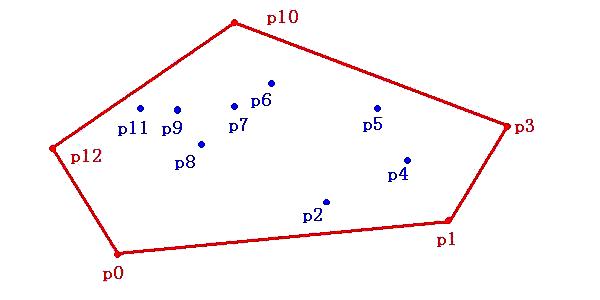给定平面上的N个点,寻找距离最远的两个点
2010-12-17 13:13
344 查看
主要是凸包算法、卡壳算法
http://blog.csdn.net/kaytowin/archive/2010/01/06/5140111.aspx
http://www.cppblog.com/staryjy/archive/2010/09/25/101412.html
/article/5198170.html
http://iamhuiam.blog.sohu.com/132378792.html

http://blog.csdn.net/kaytowin/archive/2010/01/06/5140111.aspx
http://www.cppblog.com/staryjy/archive/2010/09/25/101412.html
/article/5198170.html
http://iamhuiam.blog.sohu.com/132378792.html

#include "stdafx.h"
#include <iostream>
#include <vector>
#include <stack>
#include <algorithm>
#include <iterator>
#include <cmath>
using namespace std;
class Point
{
public:
Point(){}
Point(int m_x, int m_y):x(m_x),y(m_y){}
int x;
int y;
friend ostream& operator<< (ostream &out, const Point &point);
};
/************************************************************************/
/* 函数功能:比较两个点(先以y坐标比较,若y相同按x比较) */
/************************************************************************/
bool Cmp(const Point &left, const Point &right)
{
return ((left.y < right.y) || ((left.y == right.y) && (left.x < right.x)));
}
/************************************************************************/
/* 函数功能:求两个向量的内积 */
/************************************************************************/
int CrossProduct(const Point &pre, const Point &cur, const Point &next)//pre是上一个点,cur是当前点,next是将要选择的点
{
int x1 = cur.x - pre.x;
int y1 = cur.y - pre.y;
int x2 = cur.x - next.x;
int y2 = cur.y - next.y;
return (x1*x2 + y1*y2); //<0是满足凸包的点
}
ostream& operator<< (ostream &out, const Point &point)
{
out<<"("<<point.x<<","<<point.y<<")";
return out;
}
/************************************************************************/
/* 函数功能:求两点间的距离 */
/************************************************************************/
int Distance(const Point &point1, const Point &point2)
{
return (point1.x - point2.x)*(point1.x - point2.x) + (point1.y - point2.y)*(point1.y - point2.y);
}
/************************************************************************/
/* 函数功能:获取凸包
参数vec存放输入的点,result存放凸包上的点*/
/************************************************************************/
void GetConvexHull(vector<Point> vec, vector<Point> &result)
{
sort(vec.begin(), vec.end(), Cmp); //排序
int size = vec.size();
if(size < 3)
{
copy(vec.begin(), vec.end(), back_inserter(result));
}
else
{
result.push_back(vec.at(0));
result.push_back(vec.at(1));
result.push_back(vec.at(2));
int top = 2;
for(int i=3; i<size; i++)
{
while((top>0) && (CrossProduct(result.at(top-1), result.at(top), vec.at(i)) >= 0))
{
result.pop_back();
top--;
}
result.push_back(vec.at(i));
top++;
}
}
}
/************************************************************************/
/* 函数功能:卡壳算法(我也没搞懂) */
/************************************************************************/
int RotatingCalipers(vector<Point> vec, int n)
{
int j = 1;
int maxLength = 0;//存储最大值
vec
= vec[0];
for(int i = 0; i<n; i++)
{
while(CrossProduct(vec[i+1], vec[j+1], vec[i]) > CrossProduct(vec[i+1], vec[j], vec[i]))
j = (j+1)%n;
maxLength = max(maxLength, max(Distance(vec[i], vec[j]), Distance(vec[i+1], vec[j+1])));
}
return maxLength;
}
int main()
{
vector<Point> vec;
const int N = 20;
for(int i=0; i<N; i++)
{
vec.push_back(Point(rand()%30, rand()%30));
}
cout<<"平面上的点:"<<endl;
copy(vec.begin(), vec.end(), ostream_iterator<Point>(cout, "/n"));
cout<<endl;
vector<Point> result;
GetConvexHull(vec, result);
cout<<"凸包上的点:"<<endl;
copy(result.begin(), result.end(), ostream_iterator<Point>(cout, " "));
cout<<endl;
int distace = RotatingCalipers(result, result.size()-1);
cout<<sqrt(double(distace))<<endl;
}
相关文章推荐
- 给定平面上的N个点,寻找距离最远的两个点(转载)
- 给定平面上的N各点,寻找距离最远的两个点
- 给定平面上的N个点,寻找距离最远的两个点
- 给定平面上的N个点,寻找距离最远的两个点
- 寻找平面中距离最远的点
- 平面中有若干个点,寻找距离最近的两个点,输出其编号
- Codeforces Round #294 (Div. 2) E. A and B and Lecture Rooms(lca+思维,树上寻找与给定两个点距离相等的点的个数)
- POJ 2187:Beauty Contest 求给定一些点集里最远的两个点距离
- POJ 2187:Beauty Contest 求给定一些点集里最远的两个点距离
- 编程之美-2.11 扩展 寻找距离最远的两个点
- 【二叉树6】寻找二叉树中任意节点最远的距离
- 平面最远哈密顿距离
- 求一个二叉树中距离最远的两个节点
- 二叉树中相距最远的两个节点之间的距离
- 在二叉树中,找到距离最远的两个节点的距离
- 寻找一棵树上最远的两个节点
- 程序员面试金典——解题总结: 9.18高难度题 18.5有个内含单词的超大文本文件,给定任意两个单词,找出在这个文件中这两个单词的最短距离
- HDU 5626 Clarke and points 求平面最远哈曼顿距离
- 找出平面上距离最近的两个点
- 二叉树,给定任意两个节点,寻找最近的父节点
